
|
Note ye ed's email address: stevebryant99@gmail.com. Finally unearthed: The Little Egypt Book of Ghosts from H&R Magic Books. |

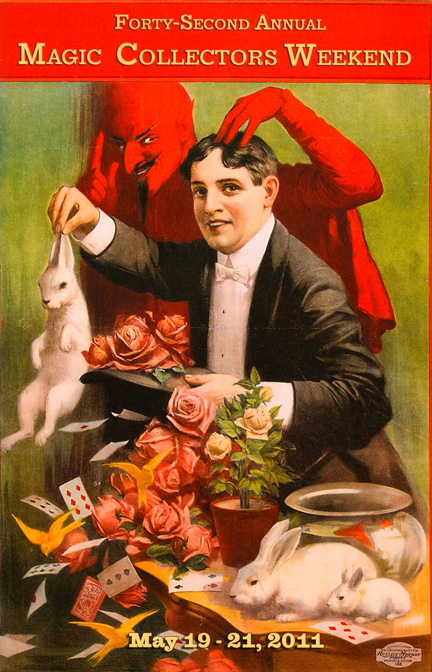
Is there a 12-step cure for this?
|
May 2011 OK, a bouquet of May flowers to you this month. We attend a David Regal lecture, peruse a Karl Fulves magazine, explore new ways to tell you which card you are merely thinking of, turn the clock back to 1959, unlock The Jinx, and enjoy the company of guys with too much disposable income at the 42nd Magic Collectors Weekend. All this, plus I understand the new Berglas book is in the mail and Erdnase's secret identity is soon to be revealed. This sounds more like an April 1 issue than a May issue. Interesting times. |
|
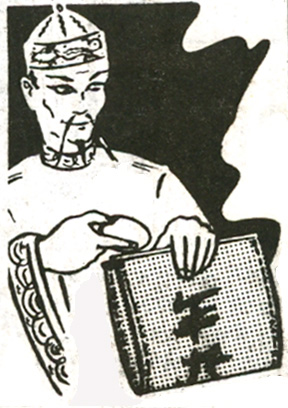 The Chinese Egg Bag, Budweiser variant. | LE LECTURE ROYALE -- As I have mentioned in the past, the DVDs that I keep at hand feature only three performers--Doc Eason, Bill Malone, and David Regal. It isn't just that their material is amazing, for it is, but that all three are so darn entertaining, seemingly effortlessly. Although I sometimes watch these DVDs to learn something, I mostly watch them for fun. It was therefore a special treat to learn that David Regal would be touring the Midwest with a lecture, and I was able to catch up with the tour at Indianapolis. I learned stuff, as expected, but mostly I enjoyed laughing and watching my fellow magicians laugh. On the learning side, David stunned us from the get-go by hiding and retrieving a full glass of beer inside a Chinese Egg Bag. Even though I had read about this a couple of years ago in David's Approaching Magic (he calls it The World's Greatest Invention), the method is so crazy that it fooled me completely. Both the glass of beer and the egg bag are completely ungimmicked, by the way. |
|
Additional items from David's book also nailed the Indy crowd. Hotel 52 is David's equivoque force of one card from 52 that ends (my fav ending, anyway) with his Disposable Deck. Change for a Five is his monte routine in which a queen and two jokers change to three fives without ever coming near the deck. A Quiet Good-bye allows you to vanish four loose, borrowed half dollars with your bare hands immediately after dribbling them from one hand to the other. The Impossible Envelope allows you to predict three detailed facts about an audience member, with no pre-show work. Cocoa is a Chop Cup routine with a marshmallow for the "ball" and a final load of hot chocolate poured from one cup to another. In additon to other items from the book, David demonstrated such marketed items as his Sudden Deck II, his Momento (signed card to block of plastic ), and his borrowed ring on chain. But as baffling as all these effects were (about a dozen killer items spread over nearly three hours of a Saturday afternoon), what made the lecture for me was how wise and funny it was. There is as much genius in the presentations as there is in the mechanics. David can slay me at times with a single word, and the word for me on this day was bullion. Too funny to explain. | |
|
|
WORD PERFECT -- Karl Fulves continues to reign as the master of clean, clear magical technical writing. His latest issue (Issue 8) of Prolix is a 72-page magazine that brings this current volume up to a whopping page 560. There is much to admire, beginning with a bold Scarne miracle revelation. Other fine items are grouped into batches, such as Teknicolor, which contains three items involving color pairings in a spectator-shuffled deck. Several involve Strippers, for which a marked deck was provided. There are a good half dozen post-Caan Craft variations on ACAAN. One-ahead systems are considered, including Mental Epic. Robin Robertson's Memorized Deck makes good use of a ploy I hadn't read before. Inkubator is an exceedingly clever routine (that begs to be performed) in which a prediction written on a playing card transfers itself to another card. Plus so much more from Roy Walton, Aldo Colombini, Sam Schwartz, Allan Lambie, and others. | |
|
THE PRINCESS DIARIES -- In The Little Egypt Book of Numbers, I included three versions of the card trick that Peter Tappan renamed The Impostress Princess, which gave me the opportunity to praise Peter's book of the same title. I shall borrow a few words of my own in praise of a new hardback version of the book, just released by Phil Willmarth. "A brief time out is in order to explain why The Impostress Princess is essential to any library of card magic. First, it's an exciting exercise in scholarship. Peter Tappan wonderfully covers the entire history of the effect, with commentary on the methods of J.B. Bobo, J.G. Thompson, Jr., and Ned Rutledge, Ray Grismer, Tom Hubbard, Richard Rowe, Al Baker, S. Leo Horowitz, Orville Meyer, Louis Histed, Paul Fox, Al Koran, Simon Aronson, and Irv Weiner, among others. There are numerous full chapters on the various sub-techniques of the effect, an important chapter on how to avoid failure, and chapters that cover many, many variations, including blindfolded methods, Hoy deck methods, methods with random plastic animals instead of cards, Tarot methods, and so on. Perhaps the strongest chapter is Peter's 'My Favorite Method.' Here he lays out a truly devastating version of the effect, with a killer intro not covered [in my book] and with an even stronger, second climax. |
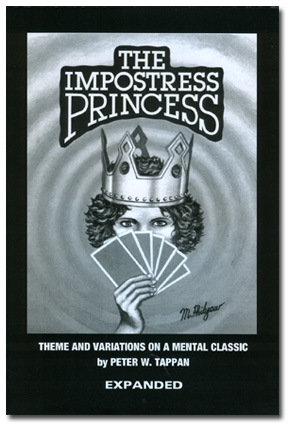 The Princess returns. |
|
"Have you always used a Si Stebbins or Eight Kings stack but worried about the too-perfect rotation of suits? Peter supplies a method for making the suit order appear random. Do you need an easy false shuffle to convince spectators that your stacked decks aren't? They are here. In all, I haven't seen this much attention to detail over one effect since some of the essays in Darwin Ortiz's The Annotated Erdnase, which contains such jewels as his exhaustive essay on ace assemblies." In addition to all the above, Phil Willmarth has added a provenance that dates the trick all the way back to 1593; he has included new contributions from David Devant, John Mendoza, Irv Weiner, Bruce Bernstein, Mike Powers, Phil Goldstein, Barrie Richardson, and Jim Steinmeyer; and he has provided an annotated appendix. You now need the book more than ever. Hardback, 137 pages, available from Phil Willmarth for $30 prior to June 30, $40 after that. | |
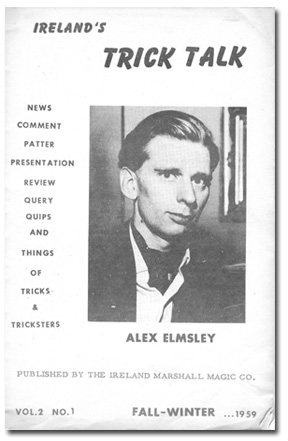 I wonder if there is a way to count four cards as four. |
BEFORE THERE WAS AN INTERNET -- Long before the internet nudged us with news of the latest and greatest from magic dealers, we received our information from the U.S. mail. One of my favorite sources during my formative days was Ireland's Trick Talk, a 24-page journal with a couple of pages of news, a magic trick or so (the issue to the left had a string trick by Charlie Miller), and the rest devoted to ads. I drooled over these items as my magic obsession took root. At Hank Moorehouse's table at the recent MCW, I was delighted to come upon a pair of Trick Talks that I had once owned, and these were more a treasure to me (at only five bucks, thanks to Hank) than was a book Mike O'Dowd was selling for $12,000. Note below a favorite from 1959, with a handsome young Alex Elmsley on its cover. At this time, Elmsley's Newspaper Tear and The Magic of Matt Schulien were still new items, and Corinda's 13 Steps to Mentalism were up to only Step 8. Johnny Platt was still at the 90's Tap, Don Alan was still at the New York Lounge, and Freddie Fah was performing on ice at the Conrad Hilton. Paris Hilton had yet to be born! All was right with the world. |
|
The ads from Trick Talk were so tempting. I bought one of these, and it really worked: 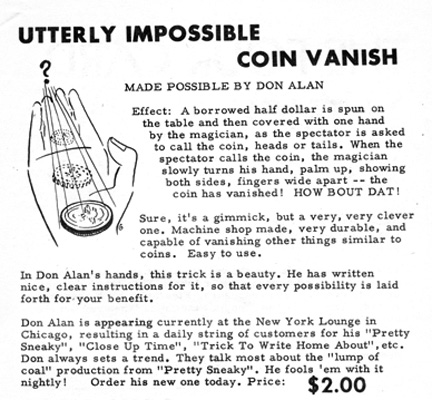 This could make you as hip as Don Alan. I bought this too, but never learned to stack consistently. Or how to be as funny as Senator Crandall. 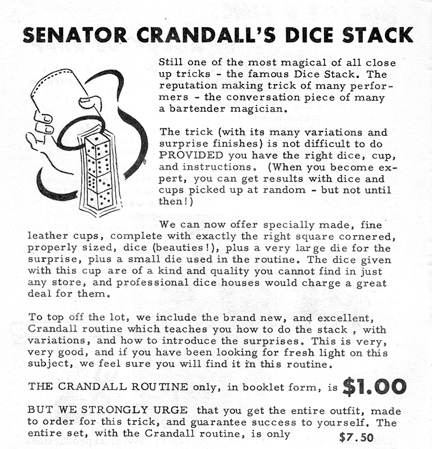 My uncle was a bartender and could do this. Ireland's had become The Ireland Marshall Magic Co. by this issue of Trick Talk, and would of course become Magic, Inc. a few years later. Magic, Inc. still flourishes at 5082 North Lincoln, where Sandy Marshall and his staff have been producing historical works such as the hardback Marlo compilations and the Jay Marshall biography Beating a Dead Horse. Check out The Marshall Chronicles for a complete review. | |
|
READER'S GUIDE -- The Jinx Companion was the most delightful literary surprise at the MCW, a runaway best seller at the H&R booth. Written by Craig Conley, Gordon Meyer, and Fredrick Turner, it is nothing short of a comprehensive reader's guide to Annemann's The Jinx. The authors spent a year reading the entire run of The Jinx, sharing their discoveries along the way, to eventually present their findings as One Jinxed Year at Jeff McBride's Magic and Meaning seminar. Working with Larry Hass, they further expanded the work into its current shape. The end result is just plain fun. You need a complete file of The Jinx to enjoy it (and you need a file period, if you are at all serious about magic). Some of its 49 sections compile the best tricks into categories ( Living and Dead, Forcing Methods, Self-Workers, Trick Decks, Stacked Decks, etc.). There are Comedy Stylings ("How did one mind reader greet the other? See The Jinx 125.). There are Trivia Stumpers ("What are the sexes of the Jinx cats? See The Jinx 81.) There are Hidden Messages (The initial letters of paragraphs, spelled backwards, harbor secrets; the Companion tells you where to look.). And so on, all in a beautiful package. The vintage typewriter fonts and illustration are collages of snippets from the original magazine and therefore "resonate with the unique character of Annemann's pages." |
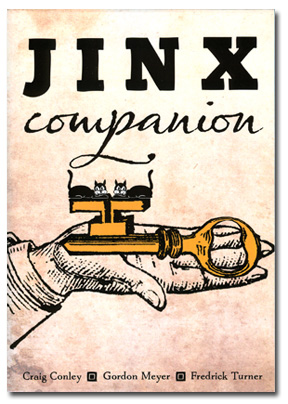 The key to Annemann's secrets. |
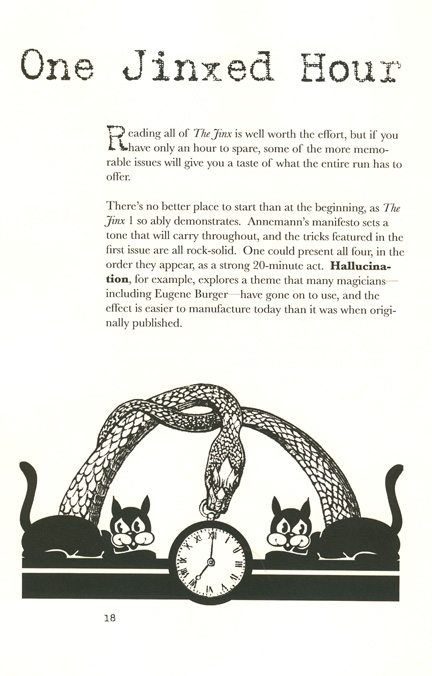 Note the vintage typewriter font. To sum up, this is a delightful book. It's clever, it's witty, it's thorough, and it's beautiful. I look forward to chasing down every reference, and I will be happy, as the authors have wished, to wind up spending more time with The Jinx than with their Companion. If I do so, then, as they say, their "lure has worked exactly as planned." Perfect bound, 150 pages, $18. I bought mine from H&R Magic Books. | |
|
|
For the second year in a row, the Magic Collectors Weekend under David Ben's Magicana transpired at the Westin Hotel in Chicago, the 42nd such convening of scholarly talks and learned fellowship. Here were old friends to hang with, great stuff to see such as Bill Palmer's cups and Del Ray's electronics, and wine and cheese and desserts to consume. Fortunately, just about all the presenters had trouble with the podium computer, so Julie Eng, who owned it, had to keep rushing to the rescue. Nice interludes. A few additional highlights ...  Julie Eng introduces Celeste Evans. TRICK PHOTOGRAPHY -- When asked during the weekend what I liked best, my answer was easy: a private moment in which John Carney exhibited his latest work on the Open Travelers. When I first saw Larry Jennings do it decades ago, I thought I was watching trick photography, and John's latest additions brought back that feeling. These are important advances, and I can only hope that John publishes them some day. John also demonstrated a beautiful slow motion color changing deck attributed to Vernon. LUNCH DATE -- My purchase of the new Peter Tappan book, reviewed elsewhere, led to lunch with its editor, Phil Willmarth. What a thrill to hear him talk of Jimmy Molinari, Jim Ryan, Ed Marlo, Tony Andruzzi, Jack Kodell, Senator Crandall, and the Schuliens. I was privy to one of the best "talks" of the convention. Phil needs to write this stuff up. | |
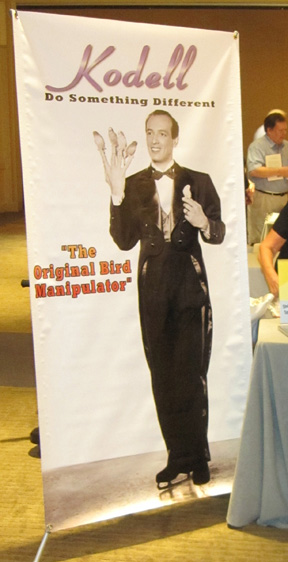 Budgies. |
BIRD MEN -- A crusty Ron Urban interviewed Jack Kodell and his wife, Mary. Jack, to catch readers up who don't know, pioneered bird magic with his multiplying parakeet act, performed on ice skates, and Ron Urban eventually benefitted from that, performing with beautiful colored doves and a white poodle, all on ice. The highlight of this segment was film of a sixteen-year-old Kodell performing his bird act. I've seen numerous teen competitions at the World Magic Seminar, and, although the kids are very, very good, they all move and look like teenagers. Kodell moved and looked like a movie star. COLLECTIONS -- The guests of honor this year were Gene Matsuura and Ray and Ann Goulet. Gene's prize possessions focussed on personal items once in the hands of Dai Vernon, Winston Freer, Slydini, and Faucett Ross, among others. (He is Dr. Matsuura, as most of you know, and his professional services had to be called upon when book dealer Andy Greget fell and injured a knee. A handy guy to have around.) Ray's collection was sort of the opposite: he seems to acquire everything (ex: 300 die boxes, 600 pieces of sheet music related to magic, etc.). After hearing his interview, I thought, "Man, Gene needs to buy some more stuff." Both gentlemen gave fascinating accounts of their collections, Gene via a prepared talk and Ray via an interview by Richard Kaufman. |
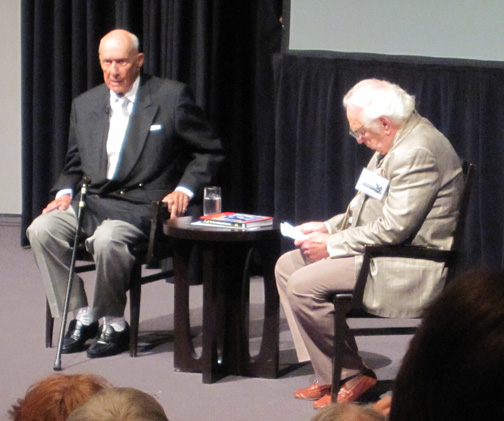 Jack Kodell and Ron Urban. BIOS -- Three new biographies were hawked at this convention, one on Kodell, one on Celeste Evans, and one on Tony Andruzzi. Kodell and Celeste represented themselves on the agenda (Celeste was inteviewed by her charming daughter), and author Jim Magus lectured on Tony. The Andruzzi book, Unspeakable Acts by Jim Magus with Terry Nosek and Neil Tobin, was the must-own for me, and I read myself to sleep the first night, somewhere in the middle, with descriptions of all seven Invocationals. Nice memories! AMATEUR HOUR -- One of my favorite parts of the MCW is the Tricks Old and Seldom Seen afternoon, at which collectors dust off and demonstrate old props. This year I particularly enjoyed David Ben's anything-but-amateur performance of a Downs coin routine (the one in which Vernon knew* Downs was using a gimmick), of Ken Klosterman's passe passe Humboldt and Globe, and of Gale Molovinsky's vanish of Jule Eng's head with a U.F. Grant prop. At one point, when Julie failed to follow Gale's directions to stick her fingers into a pair of holes, some wag shouted, "She can't hear you; her head is gone." Funny stuff. THE ERDNASIAN SOCIETY -- Saturday morning featured one of the most anticipated sessions, with three significant talks on Erdnase. Jason England led us through the history of the book itself -- its various editions, annotated versions, and works on who Erdnase was. There was a terrific Mike Caveney gag in the middle of this. Hugh McDermott spoke on why the Erdnase book could only have been published in Chicago and why its author had to be anonymous. And Richard Hatch led us through the major candidates for Erdnase's true identity, the most recent being, of all people, Stanley Wesley Stratton and Robert Andrews Millikan. The latter is the Nobel prize winning physicist whose oil drop experiment established the charge on an electron. I once performed the experiment in college, to slightly different results. If Millikan was indeed into chicanery, perhaps this lends more credence to my value. The Elephant in the Room of course was Richard Kaufman, who claims he knows who Erdnase was and will reveal the answer in the September Genii. Will this end the debate, or only fuel it moreso? We shall see.  Jason England on the Erdnase publishing history. RAGGED PERFORMANCE: The biggest disappointment to me was David Charvet's rag pictures on the Saturday night big show, simply because I was looking forward to something else entirely. I had expected to see splotches of cloth added to a background until, thanks to their positions and proportions, they "magically" coalesced into a recognizable image. This is what I always understood rag pictures to be. Instead, David applied flat felt cutouts of complete objects (a skyscraper, a cloud, etc.) to a felt background until a complete scene was formed. This is how my Sunday School teachers used to illustrate bible stories, and I can't imagine that it ever passed as entertainment. We used to call these feltboard stories. Although others shared my views after the show, David is an excellent researcher, so it raises the question: what the hell were rag pictures, anyway? (Hmm, if I am questioning David's rag pictures, perhaps I should question his offering from last year, the Phantom Ray. Perhaps it was a gag!) David's next book project is Emil Jarrow, and I look forward to it. 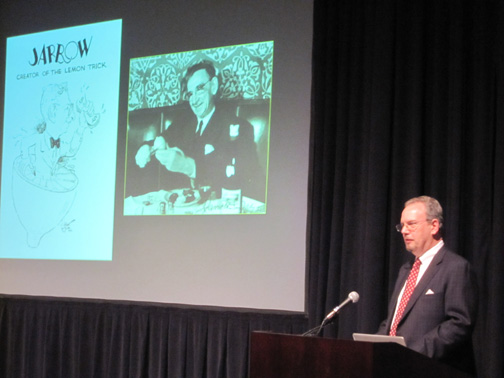 Next year -- Jarrow. BUT WAIT, THERE'S MORE -- I feel guilty leaving others out, as I enjoyed all the lectures. David Ben introduced a slide show of magic-in-advertising images courtesy of Bob James. Philip Schwartz spoke on Thayer's marketing efforts. Adam Rubin brought us up to speed on social networking possibilities. John Carney showed off some of his obscure gadgets and was the hit of the Saturday night show. (Alas, that show had no chance of measuring up to last year's, and it didn't, except for John's bit.) Bill Palmer spoke on his cups. When asked how he planned to eventually dispose of them, he revealed his plan to melt them down and reform them into a coffin. Jeff Taylor spoke on what has become of the Lund collection. And Gabe Fajuri spoke on auctions, followed by a panel discussion on the same with Mike Caveney, George Daily, and David Goodman. By the way, are we getting older? There seemed to be more emphasis throughout the talks on how to dispose of collections than on how to expand collections. Finally, Bill Spooner shared a look at Del Ray's electronics and at a Del Ray appearance on Ed Sullivan that went somewhat awry. All in all, a splendid range of information, most of it quite fascinating. There was also of course plenty of stuff to buy, including 25 spanking new copies of Richard Kaufman's The Berglas Effects, and I was pleased that two customers took home copies of The Little Egypt Book of Ghosts. Should I have warned them that the books are haunted? It's nice to hear that the weekend will convene next year in the same location, May 17-19, 2012. Meanwhile, for a better look at MCW 42, take a look at David Linsell's official photos. | |
 Ron Urban had a classy brochure. The charge on an electron is 1.6E-19 coulombs. Or is it?
*See page 228 of Dai Vernon: A Biography, by David Ben. Little Egypt Magic is the erratically updated web site of Steve Bryant, spawned (the site, not Steve) by a former internet magazine known as The Little Egypt Gazette/for magicians only. Steve Bryant is an obscure magician and writer who generates this site from an iMac in Bloomington, Indiana. He frequently journeys to and performs magic in Little Egypt, the local name for extreme southern Illinois, where the towns bear such names as Cairo, Thebes, and Karnak. Past issues of this web site: Index to Past Issues Notice: Any limited use of copyrighted images or quoted text is considered fair use, usually to review whatever product or event that is under discussion. If you object to use of any material, please get in touch and it will be cheerfully removed. |
A JSB Creations product
Copyright© 2011 by Steve Bryant